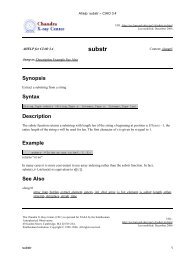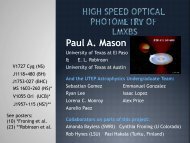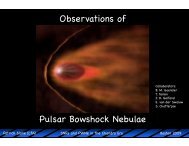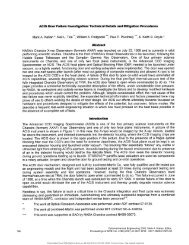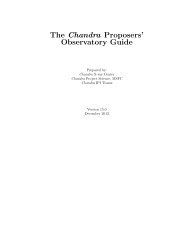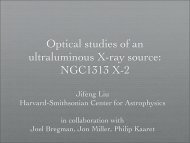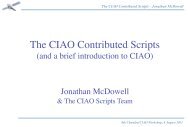Paper Title - Chandra X-Ray Observatory (CXC)
Paper Title - Chandra X-Ray Observatory (CXC)
Paper Title - Chandra X-Ray Observatory (CXC)
You also want an ePaper? Increase the reach of your titles
YUMPU automatically turns print PDFs into web optimized ePapers that Google loves.
When the mission loads are stopped, the planned attitude profile stops. As mentioned in Section 1, thermal<br />
control of several units on <strong>Chandra</strong> is now based on attitude. If the loads are stopped at the wrong attitude,<br />
the units can quickly get too hot or too cold. Additionally, planets can cross in front of the star tracker and<br />
angular momentum can accumulate quickly when an attitude is held for an unplanned period of time. If<br />
science cannot be resumed in time to avoid negative consequences of dwelling at an unplanned attitude a<br />
“maneuver only” load must be generated and uplinked. Maneuver only loads contain only the commanding<br />
required to perform a maneuver to a safe attitude and can be created far more quickly than science<br />
resumption loads. Maneuver only loads follow a slimmed down version of the nominal scheduling process.<br />
To date, the most common safing action, by far, is radiation safing. When the radiation detector senses<br />
unacceptable rates or when a decision to safe the SIs is made on the ground, the loads are stopped and the<br />
SIs stowed. This also stops the panned attitude profile. At the levels protected against by the radiation<br />
detector, radiation only poses a threat to the SIs. The vehicle could continue maneuvering without concern.<br />
Continuing the planned attitude profile would avoid the negative consequences of remaining at an<br />
unplanned attitude. It would allow for more rapid resumption of science by eliminating the need to<br />
maneuver from the attitude of the stopped observation to the first target in the resumption plan. To allow<br />
maneuvers to continue without science commanding, engineering and science loads must be separated, but<br />
run concurrently. When a safety issue threatens the SIs, but not the rest of the vehicle, only the science<br />
loads can be stopped. If a safety issue threatens both, then both sets can be stopped. In anticipation of the<br />
next solar maximum, the <strong>Chandra</strong> FOT is investigating changing the ground and flight software to allow<br />
this separation.<br />
3.3. Anomaly Response<br />
To date, the anomalies on <strong>Chandra</strong> have been detected well before they caused a safing monitor limit to be<br />
reached. Several anomalies have, however, required changes to mission schedules. If the running loads<br />
must be reworked to mitigate or work around an anomaly, the TOO scheduling process, without the effort<br />
of generating an OR for a new observation, is used to re-plan observations and engineering activities. If the<br />
loads cannot be reworked in-time to avoid undesirable reconfigurations, then they will be stopped and the<br />
SIs stowed. In this case, the safing response re-plan process is followed.<br />
When an anomaly requires a long term change to the scheduling process, the MPCWG coordinates the<br />
required changes. New constraints often start out very conservative. The conservatism combined with the<br />
learning curve for schedulers working with a new rule and the lack of automated tools to help adhere to the<br />
new constraint can cause a temporary decline in scheduling efficiency and increase in scheduling effort.<br />
The MPCWG works to mitigate the decline, by investigating safe ways to relax the new constraint and<br />
methods to help the planners work within it.<br />
4. Conclusions<br />
The mission scheduling process requires balancing many factors, such as, observation constraints, observer<br />
preferences, maneuver size, momentum accumulation and unloading, mechanism motions, thermal<br />
management and attitude restrictions. Such a complex problem leads people to want to develop an<br />
algorithm that does all of the work, a “black box” scheduling system that ingests requests and outputs a<br />
schedule with no manual intervention. However, such a system simply cannot support rapid changes to<br />
constraints and priorities and cannot answer questions when problems arise. Maintaining mission<br />
scheduling capability in the face of evolving constraints and expectations requires a method that allows<br />
specifying how requests are scheduled. To prevent such specifications from being trail and error, the<br />
system must provide the user with the information required to make scheduling decisions. The <strong>Chandra</strong><br />
Mission Planners use visual representations of the schedule and the constraints to assemble a set of<br />
maneuvers and dwells that achieves the scientific goals of the mission, without compromising vehicle<br />
safety, in the most efficient manner possible. Optimization routines can be very helpful in solving the<br />
complex problem of mission scheduling, but they cannot be the only answer. A scheduling algorithm<br />
cannot work with engineers as constraints evolve, and cannot rapidly change its priorities and rules the way<br />
the human brain can. Adaptive mission scheduling requires a balance of automated tools and human input.



